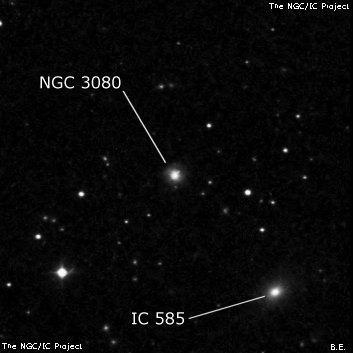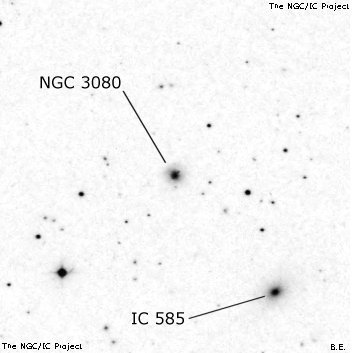NGC/IC Project Restoration Effort
(This is a very very beta version)
NGC3080


Basic Information
Location and Magnitude
Right Ascension: 9:59:55.9
Declination: +13:2:39
Constellation: LEO
Visual Magnitude: 13.6
Historic Information
Discoverer: Herschel W.
Year of discovery: 1794
Discovery aperture: 18.7
Observational
Summary description: vF
Sub-type: Sa
Corwin's Notes
=====
NGC 3080 is close to IC 585. Both were seen by Bigourdan who got the NGC
number on the correct object. I had some question about that as his position
is somewhat different from the NGC position.
The NGC position apparently comes from CH; it is based on a single observation
by WH who compared it to "the Georgian Planet" on 1 April 1794. After some
fussing about looking for an on-line ephemeris, Brian Skiff pointed me at
JPL's "Horizons". Jon Giorgini, one of Horizons maintainers, set me straight
on its use, so I was able to find that Uranus was at 09 57 30.0, +13 17 24
(B1950.0) on the night that WH used it as a comparison object. This position,
combined with WH's offsets (16 seconds preceding, 2 arcmin south) fell within
1.5 arcmin of NGC 3080, the brighter of the two galaxies.
Fortunately, not only did Bigourdan get it right, but he published a
correction to the NGC position that ended up in the IC2 Notes. Even that
position, however, is a bit off because he used the old BD position for his
comparison star. Once that is corrected, and proper motion taken into
account, his position lands within a few arcseconds of the modern ones.
Steve's Notes
=====
NGC 3080
17.5" (3/29/97): faint, small, round, 40" diameter, weak even concentration to a slightly brighter core. A mag 13.5 star lies 2.1' WSW. IC 585, located 4.4' SSW, appeared faint, small, round, bright core, 40" diameter. IC 585 is very similar in size and magnitude to NGC 3080 and surprisingly, possibly easier visually due a brighter core.



